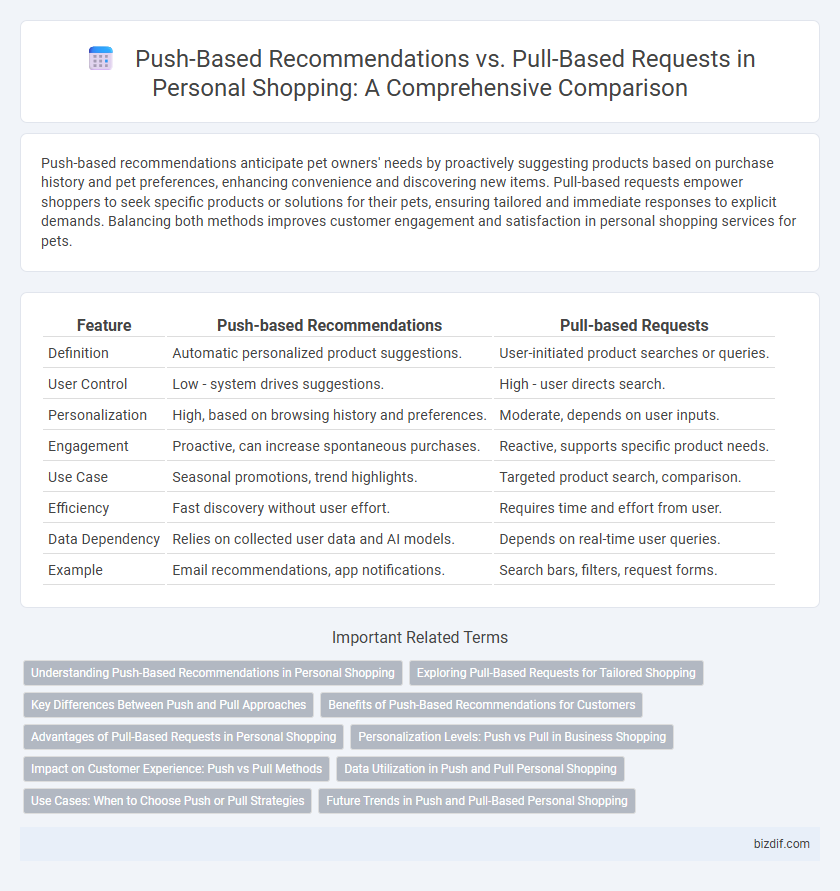Push-based recommendations anticipate pet owners' needs by proactively suggesting products based on purchase history and pet preferences, enhancing convenience and discovering new items. Pull-based requests empower shoppers to seek specific products or solutions for their pets, ensuring tailored and immediate responses to explicit demands. Balancing both methods improves customer engagement and satisfaction in personal shopping services for pets.
Table of Comparison
| Feature | Push-based Recommendations | Pull-based Requests |
|---|---|---|
| Definition | Automatic personalized product suggestions. | User-initiated product searches or queries. |
| User Control | Low - system drives suggestions. | High - user directs search. |
| Personalization | High, based on browsing history and preferences. | Moderate, depends on user inputs. |
| Engagement | Proactive, can increase spontaneous purchases. | Reactive, supports specific product needs. |
| Use Case | Seasonal promotions, trend highlights. | Targeted product search, comparison. |
| Efficiency | Fast discovery without user effort. | Requires time and effort from user. |
| Data Dependency | Relies on collected user data and AI models. | Depends on real-time user queries. |
| Example | Email recommendations, app notifications. | Search bars, filters, request forms. |
Understanding Push-Based Recommendations in Personal Shopping
Push-based recommendations in personal shopping utilize predictive algorithms and customer data to automatically suggest products tailored to individual preferences without active user input. This proactive approach increases engagement by delivering relevant offers, boosting conversion rates and enhancing customer experience. Retailers leverage behavioral analytics, purchase history, and real-time trends to optimize these suggestions, creating a dynamic and personalized shopping journey.
Exploring Pull-Based Requests for Tailored Shopping
Pull-based requests empower shoppers to actively seek personalized product suggestions by specifying their preferences and needs, enhancing the relevance of recommendations. This approach leverages real-time data input from users to deliver tailored shopping experiences, increasing customer satisfaction and engagement. By prioritizing user-driven queries, retailers can refine inventory suggestions, improving conversion rates and fostering brand loyalty.
Key Differences Between Push and Pull Approaches
Push-based recommendations proactively deliver personalized product suggestions to consumers based on their browsing history, purchase behavior, and demographic data, enhancing discovery without explicit requests. Pull-based requests rely on customers actively searching or asking for specific products, ensuring intent-driven engagement but requiring user initiation. Push strategies focus on increasing visibility and impulse buying, while pull emphasizes meeting precise customer needs through targeted queries.
Benefits of Push-Based Recommendations for Customers
Push-based recommendations offer customers a personalized shopping experience by proactively delivering tailored product suggestions based on their browsing and purchase history. This approach saves time and effort by anticipating customer needs, enhancing convenience and increasing the likelihood of discovering relevant items. The seamless integration of push notifications and alerts ensures customers stay informed about exclusive deals and new arrivals without actively searching for them.
Advantages of Pull-Based Requests in Personal Shopping
Pull-based requests in personal shopping empower customers to actively seek tailored product suggestions, enhancing satisfaction through personalized control over their shopping experience. These requests enable real-time updates and relevant product discovery based on user-initiated queries, improving accuracy and engagement. By relying on explicit customer input, pull-based models reduce irrelevant recommendations, fostering trust and efficiency in the shopping journey.
Personalization Levels: Push vs Pull in Business Shopping
Push-based recommendations in personal shopping leverage advanced algorithms and customer data analytics to anticipate business buyers' needs, delivering personalized product suggestions proactively to enhance decision-making efficiency. Pull-based requests rely on the shopper's active input, offering tailored options based on real-time queries and preferences, ensuring high relevance through direct engagement. Businesses that integrate push and pull personalization techniques optimize customer experience by balancing proactive insights with responsive customization, resulting in increased satisfaction and conversion rates.
Impact on Customer Experience: Push vs Pull Methods
Push-based recommendations proactively deliver personalized product suggestions based on customer behavior, increasing engagement by anticipating needs and reducing decision fatigue. Pull-based requests empower customers to seek specific information or products, fostering control and satisfaction through active participation. Optimizing the balance between push and pull methods enhances the personal shopping experience by combining tailored discovery with user-driven exploration.
Data Utilization in Push and Pull Personal Shopping
Push-based recommendations leverage real-time customer data, such as browsing history and purchase patterns, to proactively suggest personalized products, maximizing data utilization for targeted marketing. Pull-based requests depend on explicit user input, like search queries or filters, limiting data use to the information directly provided by the customer. Effective personal shopping systems combine both approaches to optimize data-driven insights and enhance user experience through seamless personalization.
Use Cases: When to Choose Push or Pull Strategies
Push-based recommendations excel in personalized promotions and product discovery by proactively surfacing items based on user behavior, ideal for increasing engagement and upselling. Pull-based requests work best for shoppers who have specific needs or intent, as they enable precise, on-demand search and filtering within personal shopping apps. Brands aiming to balance relevance and user control should integrate push strategies for inspiration and pull strategies for goal-driven shopping experiences.
Future Trends in Push and Pull-Based Personal Shopping
Future trends in push-based personal shopping emphasize AI-driven predictive analytics to deliver hyper-personalized product suggestions before customers express interest. Pull-based requests are evolving with voice-activated assistants and real-time search algorithms that enable consumers to quickly retrieve tailored shopping options on demand. Integration of augmented reality and seamless omnichannel experiences will enhance both push and pull models by creating intuitive and immersive decision-making environments.
Push-based recommendations vs Pull-based requests Infographic

 bizdif.com
bizdif.com